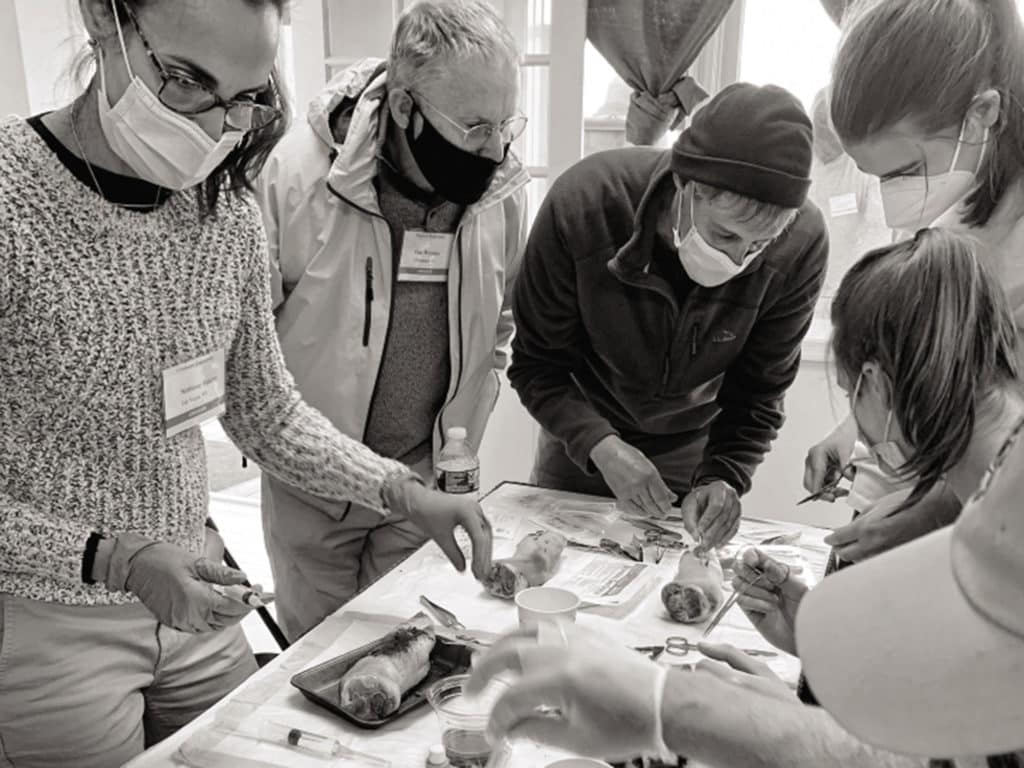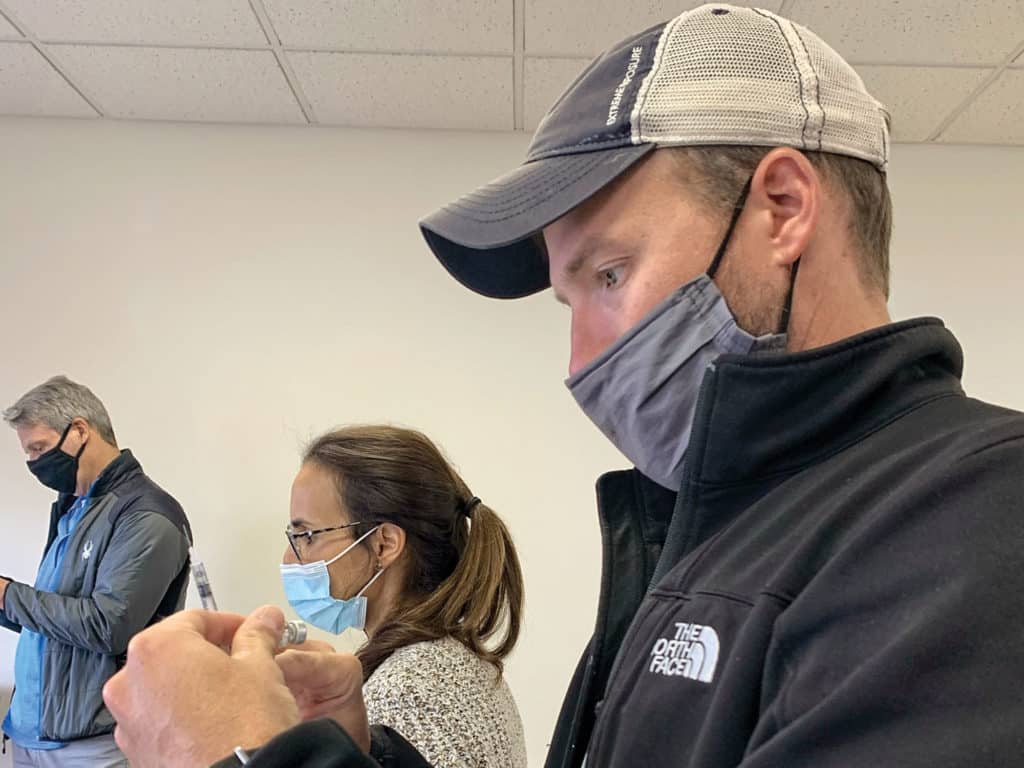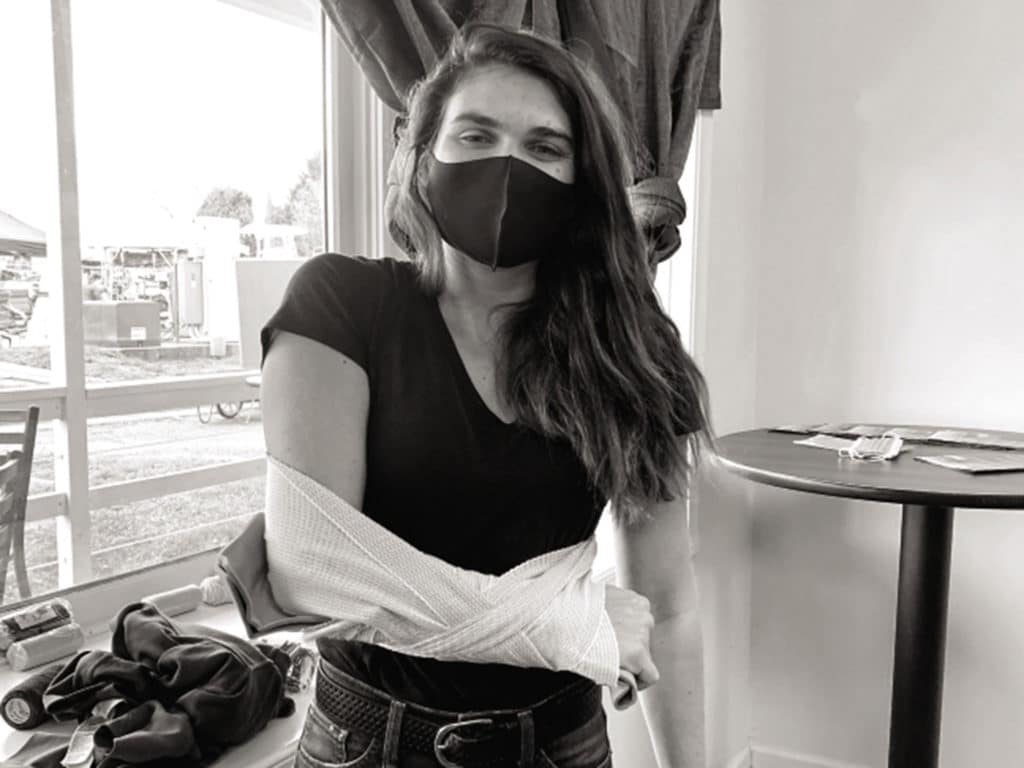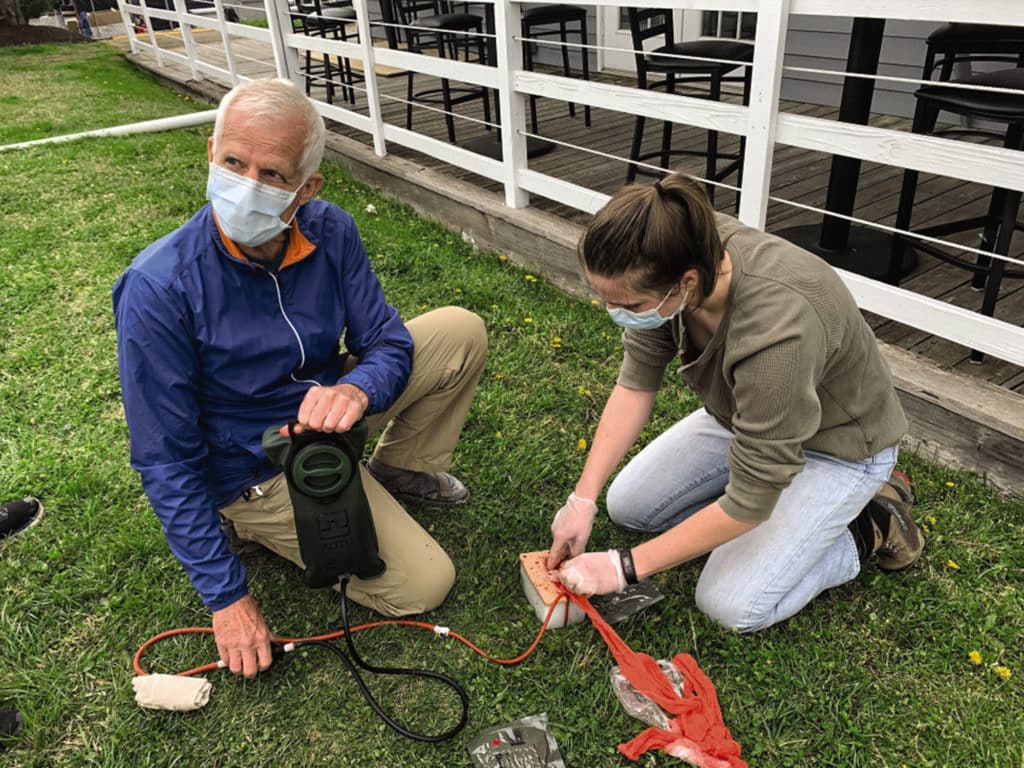
Right away, Dr. David Johnson launched into a scenario: “A 42-year-old man is struck in the head by the boom during a jibe. The boat and crew are 100 miles south of Halifax, Nova Scotia, in 12 knots of breeze; it is 1400, and the sky is clear. The helm reports that the patient was knocked out for a few seconds. Patient now complains of a mild headache. Serious or not serious?”
The class glanced around at one another before someone piped up, “Serious?”
“How do you know?” asked Johnson—or DJ, as he likes to be called.
“Well, because of the headache?”
You’re on the right track, DJ said, but you need more information. DJ, an emergency physician, along with co-instructor Jeff Isaac, a physician associate and wilderness EMT, were leading the Offshore Emergency Medicine course at the 2021 Bay Bridge Boat Show in Stevensville, Maryland. They went on to give more details of the scenario and spoke on how different elements can tip the situation one way or the other. A patient’s symptoms and medical history, the location of the boat, and the crew’s preparedness can mean the difference between a challenging situation and a full-blown medical emergency.
As someone who cruises with just my husband and daughters, my biggest fears could be summed up as medical “what-ifs.”
As someone who typically cruises with just my husband and daughters, my biggest fears could usually be summed up as medical “what-ifs.” What if my husband broke a bone? What if my daughter had an allergic reaction or got an infection? Would I know how to handle it? What should be in our first-aid kit? I knew that I wanted some medical training before going cruising again, and the OEM course seemed ideal. The three-day program is designed for sailors who travel far from medical assistance, and the intensity and scope of content covered made it more relevant than typical wilderness first-aid courses. DJ’s jibe scenario tested our attempts to diagnose a traumatic brain injury—serious business from the get-go. By 8:30 on Day One, I was glad that I had (mostly) done my assigned reading. I would have been lost otherwise.
I was not alone in my fears and my desire to learn. Norhi Folsom, one of my classmates, lives with her husband and kids in Las Vegas. The family is planning to circumnavigate aboard a Balance 526 catamaran. While waiting for the cat’s expected fall 2022 delivery, they were testing their cruising legs aboard a Lagoon 420 and exploring the US East Coast and the Bahamas. Norhi took the OEM course, she said, because of her uneasiness about her ability to handle an emergency.
“I’m not a doctor; I’m not a nurse. But I figured I could get some basic knowledge to mitigate a medical situation with some planning and preparation,” Norhi said.
Now in its 25th year, the popular OEM course, run by Wilderness Medical Associates, is offered several times annually. My 20 classmates included a young Coastie and his girlfriend who are planning an open-ended cruise; a family of four who are preparing for extended cruising aboard a catamaran; an EMT earning continuing-education credits; and a racing crew preparing for the 2022 Newport Bermuda Race. Our experience was an intense three days of classroom and hands-on learning.
When students register for the course, they’re given access to an online classroom portal where they can find the course materials, including the textbook (Wilderness and Rescue Medicine), case studies and a pre-test. Full disclosure: I found the test hard, even with all the materials at hand. It was immediately evident that this was not going to be a typical first-aid class. DJ and Jeff recommend taking first aid and CPR before the OEM course because knowledge of basic skills are assumed and aren’t covered.
While the OEM course is different than a backcountry-medicine course, both are rooted in the same principles: managing an emergency when one has delayed access to medical care, in a hostile environment, with limited equipment. Both DJ and Jeff have extensive experience offshore, along with experience in the deep wilderness and on ski slopes. Every concept they presented was rooted in risk-versus-benefit decision-making, which leads to a plan of care for the patient. As Jeff put it, “Sailors inherently know that risk is a function of probability and consequence.”
Keeping someone stable, hydrated and comfortable are some of the most integral parts of the game plan.
Day One—which covered what DJ called “the big, bad stuff”—was the most intense. We touched on all the things you hope never happen on your boat, and practiced the process needed to logically deal with these situations. Shock (a failure of the circulatory system), respiratory failure and brain failure are the three biggies. We learned how seemingly small things—a jellyfish sting, seasickness, a headache—can lead to one of the biggies if not taken care of early. It was sobering, to say the least.
The importance of communication was another aspect we practiced. “Have a plan in place when calling the Coast Guard,” Jeff said. “Do you want a check-in schedule? A medical evacuation?” During breakout sessions, we teamed up with classmates—one person played the victim and the other, the responder. Victims were given a scenario to act out, and responders were challenged to form a diagnosis and to communicate the situation. We delivered our assessments succinctly to the class, as if relaying the information to rescuers or to a doctor over a radio or satphone. It wasn’t all doom and gloom. DJ told us that most patients live if they survive the initial trauma. With his experience as an emergency physician, I figured he’d know.

For patient treatment, we focused on low-risk procedures that solve high-risk problems. Keeping someone stable, hydrated and comfortable is the most integral part of the game plan. Deciding whether to call for rescue or alter course to a closer destination with a medical facility weighs into the risk-versus-benefit analysis. Weather and the capabilities of the crew should always be considered. “Most people will do better with basic care aboard than with a complicated evacuation,” DJ added.
I was looking forward to the second day with equal amounts of dread and excitement. The syllabus called for a deep dive into serious injuries and, being a bit squeamish, I was nervous. Our morning classroom discussion brought home the importance of gathering health information from each crewmember and requesting that all crew have a physical and a dental checkup before heading offshore. Next up, the squeamish-inducing stuff: wound care, pain management and musculoskeletal injuries. We quickly learned why having a history for each crewmember is important. Knowing that someone has an allergy to an antibiotic or is on medication can keep a bad situation from getting much worse.

After lunch, we reconvened around tables loaded with all sorts of medical equipment: blood-pressure cuffs and stethoscopes, pressure dressings and syringes. We practiced wound cleaning on pigs’ feet fresh from a butcher shop, and rehearsed giving injections. DJ and Jeff showed us a slew of techniques and answered a load of questions. It was empowering and overwhelming at the same time.
By Day Three, I felt like things were finally clicking. Our last day we covered illnesses and what DJ called “weird tropical stuff” (dengue fever, skin infections from coral cuts, and insect bites), and walked through what an ideal medical kit might look like, including which medications. With this course tailored for offshore sailing, DJ and Jeff were able to focus on the types of illnesses and conditions that sailors are most likely to come across: hypothermia, heat exhaustion, dehydration, heat stroke, injuries from lightning, and toxins from marine life. We also went through common maladies such as earaches, diarrhea, respiratory infections and skin rashes, noting that dealing with the small things early and efficiently keeps them from becoming serious.
RELATED: Safety at Sea: Mental Preparations Contribute to Positive Outcomes
Our discussion of medical kits made me realize how inadequate most kits are for long-distance cruising. “For bluewater passages and remote cruising grounds, you will need a medical toolbox equipped for self-sufficiency and the long haul,” Jeff noted. He recommended we add more Ace bandages to a basic kit, along with waterproof and blister Band-Aids; burn gel and large gel pads for burns; a CPR pocket mask and a nasopharyngeal airway kit; pressure dressings, tourniquet and sterile wound packing for bleeding. Keep in mind before you add something to your medical kit that you need to know how to use it.
“For bluewater passages and remote cruising grounds, you will need a medical toolbox equipped for self-sufficiency.”
As Norhi prepares for her family’s circumnavigation, she said that the medical kit is something that will get plenty of attention. “The course definitely had an impact on my provisioning. There are quite a few items sold in medical kits that are not as helpful or not multifunctional. This course not only pointed those out, but it also gave suggestions on better options and, should space allow, extras. I’m putting together my own medical kit.”

Eric Irwin, who is preparing for the 2022 Newport Bermuda Race, attended the class with fellow crewmember Marcus Wunderlich. Eric is a 30-year Navy veteran with long-distance ocean-racing experience. For Eric, the biggest takeaways from the course were learning what is life-threatening and critical, and what is not, in order to make risky decisions when responding to a medical event, as well as communicating medical status to personnel who are available to support and respond. Attending with Marcus—who, while not a doctor by profession, will serve as their boat’s doctor during the race—was beneficial, Eric said, because in the event of a medical emergency, they will have a shared vocabulary from the course, and a set of valuable skills.
For Marcus, his major takeaway was more physical. “I now have more of an understanding of how human life works—perfusion of human tissue by oxygenated blood—and the organs fundamentally involved, and how to preserve the functionality of these organs.”
Norhi’s thoughts echoed my own. “My biggest takeaway from the course is understanding that pain and a little blood are not necessarily emergencies, while shock or nervous system failure are emergencies,” she said. Learning a systematic way of surveying a patient, diagnosing and treating the patient, and conveying data to medical professionals are all extremely important, she said, as is staying focused during what can be a chaotic time.
After this course, I’ve come to understand that medical training is not a one-and-done thing, and I plan to take more first-aid courses in the future, particularly before heading off on our next adventure. My personal goal for the course was to have a better understanding of emergency medical care and to build confidence about what I should do if faced with an onboard medical emergency, which I feel I’ve accomplished. Similar to our life raft and EPIRB, though, it’s something I hope I’ll never have to use.
Jennifer Brett is a CW editor-at-large.
For information and to check out the schedule of upcoming classes, visit wildmed.com.








